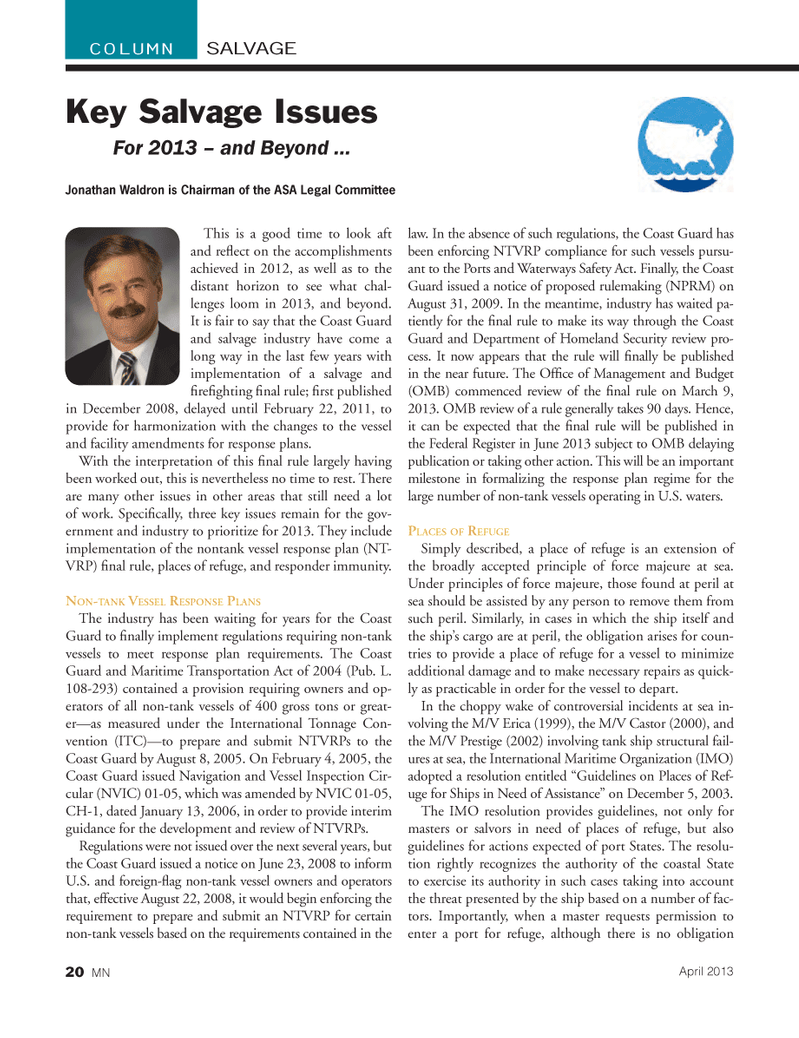
Page 20: of Marine News Magazine (April 2013)
Offshore Service Operators
Read this page in Pdf, Flash or Html5 edition of April 2013 Marine News Magazine
This is a good time to look aft and reß ect on the accomplishments achieved in 2012, as well as to the distant horizon to see what chal- lenges loom in 2013, and beyond. It is fair to say that the Coast Guard and salvage industry have come a long way in the last few years with implementation of a salvage and Þ reÞ ghting Þ nal rule; Þ rst published in December 2008, delayed until February 22, 2011, to provide for harmonization with the changes to the vessel and facility amendments for response plans. With the interpretation of this Þ nal rule largely having been worked out, this is nevertheless no time to rest. There are many other issues in other areas that still need a lot of work. SpeciÞ cally, three key issues remain for the gov- ernment and industry to prioritize for 2013. They include implementation of the nontank vessel response plan (NT- VRP) Þ nal rule, places of refuge, and responder immunity. NON-TANK VESSEL RESPONSE PLANS The industry has been waiting for years for the Coast Guard to Þ nally implement regulations requiring non-tank vessels to meet response plan requirements. The Coast Guard and Maritime Transportation Act of 2004 (Pub. L. 108-293) contained a provision requiring owners and op- erators of all non-tank vessels of 400 gross tons or great- erÑas measured under the International Tonnage Con- vention (ITC)Ñto prepare and submit NTVRPs to the Coast Guard by August 8, 2005. On February 4, 2005, the Coast Guard issued Navigation and Vessel Inspection Cir- cular (NVIC) 01-05, which was amended by NVIC 01-05, CH-1, dated January 13, 2006, in order to provide interim guidance for the development and review of NTVRPs. Regulations were not issued over the next several years, but the Coast Guard issued a notice on June 23, 2008 to inform U.S. and foreign-ß ag non-tank vessel owners and operators that, effective August 22, 2008, it would begin enforcing the requirement to prepare and submit an NTVRP for certain non-tank vessels based on the requirements contained in the law. In the absence of such regulations, the Coast Guard has been enforcing NTVRP compliance for such vessels pursu- ant to the Ports and Waterways Safety Act. Finally, the Coast Guard issued a notice of proposed rulemaking (NPRM) on August 31, 2009. In the meantime, industry has waited pa- tiently for the Þ nal rule to make its way through the Coast Guard and Department of Homeland Security review pro- cess. It now appears that the rule will Þ nally be published in the near future. The OfÞ ce of Management and Budget (OMB) commenced review of the Þ nal rule on March 9, 2013. OMB review of a rule generally takes 90 days. Hence, it can be expected that the Þ nal rule will be published in the Federal Register in June 2013 subject to OMB delaying publication or taking other action. This will be an important milestone in formalizing the response plan regime for the large number of non-tank vessels operating in U.S. waters. PLACES OF REFUGESimply described, a place of refuge is an extension of the broadly accepted principle of force majeure at sea. Under principles of force majeure, those found at peril at sea should be assisted by any person to remove them from such peril. Similarly, in cases in which the ship itself and the shipÕs cargo are at peril, the obligation arises for coun- tries to provide a place of refuge for a vessel to minimize additional damage and to make necessary repairs as quick- ly as practicable in order for the vessel to depart. In the choppy wake of controversial incidents at sea in- volving the M/V Erica (1999), the M/V Castor (2000), and the M/V Prestige (2002) involving tank ship structural fail- ures at sea, the International Maritime Organization (IMO) adopted a resolution entitled ÒGuidelines on Places of Ref- uge for Ships in Need of AssistanceÓ on December 5, 2003. The IMO resolution provides guidelines, not only for masters or salvors in need of places of refuge, but also guidelines for actions expected of port States. The resolu- tion rightly recognizes the authority of the coastal State to exercise its authority in such cases taking into account the threat presented by the ship based on a number of fac- tors. Importantly, when a master requests permission to enter a port for refuge, although there is no obligation Key Salvage Issues For 2013 ? and Beyond ? Jonathan Waldron is Chairman of the ASA Legal Committee SALVAGE COLUMN20 MNApril 2013MN April2013 Layout 18-31.indd 20MN April2013 Layout 18-31.indd 204/1/2013 11:29:32 AM4/1/2013 11:29:32 AM

 19
19

 21
21
